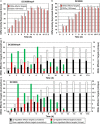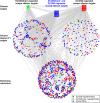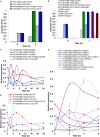Global temporal dynamic landscape of pathogen-mediated subversion of Arabidopsis innate immunity
- PMID: 28798368
- PMCID: PMC5552879
- DOI: 10.1038/s41598-017-08073-z
Global temporal dynamic landscape of pathogen-mediated subversion of Arabidopsis innate immunity
Abstract
The universal nature of networks' structural and physical properties across diverse systems offers a better prospect to elucidate the interplay between a system and its environment. In the last decade, several large-scale transcriptome and interactome studies were conducted to understand the complex and dynamic nature of interactions between Arabidopsis and its bacterial pathogen, Pseudomonas syringae pv. tomato DC3000. We took advantage of these publicly available datasets and performed "-omics"-based integrative, and network topology analyses to decipher the transcriptional and protein-protein interaction activities of effector targets. We demonstrated that effector targets exhibit shorter distance to differentially expressed genes (DEGs) and possess increased information centrality. Intriguingly, effector targets are differentially expressed in a sequential manner and make for 1% of the total DEGs at any time point of infection with virulent or defense-inducing DC3000 strains. We revealed that DC3000 significantly alters the expression levels of 71% effector targets and their downstream physical interacting proteins in Arabidopsis interactome. Our integrative "-omics"--based analyses identified dynamic complexes associated with MTI and disease susceptibility. Finally, we discovered five novel plant defense players using a systems biology-fueled top-to-bottom approach and demonstrated immune-related functions for them, further validating the power and resolution of our network analyses.
Conflict of interest statement
The authors declare that they have no competing interests.
Figures






Similar articles
-
Genome-wide transcriptional analysis of the Arabidopsis thaliana interaction with the plant pathogen Pseudomonas syringae pv. tomato DC3000 and the human pathogen Escherichia coli O157:H7.Plant J. 2006 Apr;46(1):34-53. doi: 10.1111/j.1365-313X.2006.02725.x. Plant J. 2006. PMID: 16553894
-
Flagellin induces innate immunity in nonhost interactions that is suppressed by Pseudomonas syringae effectors.Proc Natl Acad Sci U S A. 2005 Sep 6;102(36):12990-5. doi: 10.1073/pnas.0502425102. Epub 2005 Aug 25. Proc Natl Acad Sci U S A. 2005. PMID: 16123135 Free PMC article.
-
Melatonin induces nitric oxide and the potential mechanisms relate to innate immunity against bacterial pathogen infection in Arabidopsis.J Pineal Res. 2015 Aug;59(1):102-8. doi: 10.1111/jpi.12244. Epub 2015 May 26. J Pineal Res. 2015. PMID: 25960153
-
A Method for Investigating the Pseudomonas syringae-Arabidopsis thaliana Pathosystem Under Various Light Environments.Methods Mol Biol. 2019;1991:107-113. doi: 10.1007/978-1-4939-9458-8_12. Methods Mol Biol. 2019. PMID: 31041768
-
Gene networks underlying the early regulation of Paraburkholderia phytofirmans PsJN induced systemic resistance in Arabidopsis.PLoS One. 2019 Aug 22;14(8):e0221358. doi: 10.1371/journal.pone.0221358. eCollection 2019. PLoS One. 2019. PMID: 31437216 Free PMC article.
Cited by
-
Network Biology Analyses and Dynamic Modeling of Gene Regulatory Networks under Drought Stress Reveal Major Transcriptional Regulators in Arabidopsis.Int J Mol Sci. 2023 Apr 16;24(8):7349. doi: 10.3390/ijms24087349. Int J Mol Sci. 2023. PMID: 37108512 Free PMC article.
-
Dynamic modeling of transcriptional gene regulatory network uncovers distinct pathways during the onset of Arabidopsis leaf senescence.NPJ Syst Biol Appl. 2018 Aug 31;4:35. doi: 10.1038/s41540-018-0071-2. eCollection 2018. NPJ Syst Biol Appl. 2018. PMID: 30181903 Free PMC article.
-
Cytotrap: An Innovative Approach for Protein-Protein Interaction Studies for Cytoplasmic Proteins.Methods Mol Biol. 2023;2690:9-22. doi: 10.1007/978-1-0716-3327-4_2. Methods Mol Biol. 2023. PMID: 37450133
-
Transcriptional circuitry atlas of genetic diverse unstimulated murine and human macrophages define disparity in population-wide innate immunity.Sci Rep. 2021 Apr 1;11(1):7373. doi: 10.1038/s41598-021-86742-w. Sci Rep. 2021. PMID: 33795737 Free PMC article.
-
Protein-Protein Interaction Network Exploration Using Cytoscape.Methods Mol Biol. 2023;2690:419-427. doi: 10.1007/978-1-0716-3327-4_32. Methods Mol Biol. 2023. PMID: 37450163
References
-
- McCormack ME, Lopez JA, Crocker TH, Mukhtar MS. Making the right connections: Network biology and plant immune system dynamics. Current Plant Biology. 2016;5:1–12. doi: 10.1016/j.cpb.2015.10.002. - DOI
Publication types
MeSH terms
LinkOut - more resources
Full Text Sources
Other Literature Sources

